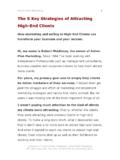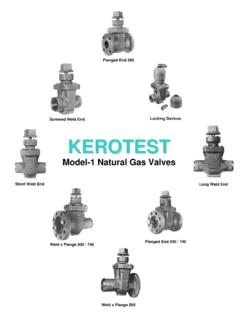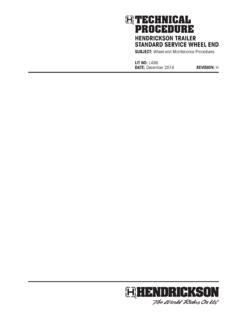Transcription of Wet Granulation: End-Point Determination - mcc …
1 Page 1 of 18 Wet granulation : End-Point Determination by Michael Levin, Ph. D. Measurement Control Corporation East Hanover, New Jersey, USA What is an End-Point ? End-Point can be defined by the formulator as a target particle size mean or distribution. Alternatively, the End-Point can be defined in rheological terms. It has been shown (15) that once you have reached the desired End-Point , the granule properties and the subsequent tablet properties are very similar regardless of the granulation processing factors, such as impeller or chopper speed or binder addition rate. I would call this the principle of equifinality . The ultimate goal of any measurement in a granulation process is to estimate viscosity and density of the granules, and, perhaps, to obtain an indication of the particle size mean and distribution. One of the ways to obtain this information is by measuring load on the main impeller.
2 Mixer instrumentation, in general, has numerous benefits. In addition to a possible End-Point Determination , it can be used to troubleshoot the machine performance (for example, help detect worn-out gears and pulleys or identify mixing and binder irregularities). Instrumentation can serve as a tool for formulation fingerprinting, assure batch reproducibility, aid in raw material evaluation, process optimization and scale-up. End-Point Determination End-Point detection in wet granulation has become a major scientific and technological challenge (74). Monitoring granulation is most commonly achieved by collecting either power or torque signals, or both. In what follows, we will compare both methods. How to determine an End-Point ? A wet granulation End-Point should be defined empirically in terms of wet mass density and viscosity, particle size distribution, flowability or tableting parameters ( , capping compression).
3 It is advisable to run a trial batch at a fixed speed and with a predetermined method of binder addition (for example, add water continuously at a fixed rate to a dry mix with a water-soluble binding agent). Before adding the liquid, measure the baseline level of motor power consumption Po or impeller torque o at the dry mix stage. During the batch, stop the process frequently times to take samples and, for each sample, note the End-Point values of power consumption Pe or impeller torque e. For each of these end- points , measure the resulting wet mass density . As a result, you will be able to obtain some data that will relate the End-Point parameters listed above with the processing variables in terms of net motor power consumption Pm = (Pe - Po) or net Page 2 of 18 impeller power consumption Pi = 2 n ( e - o), where n is the impeller speed [dimension T-1].
4 Torque vs. Power When we say power consumption , we usually refer to the main motor. It reflects the load on the motor due to useful work, as well as the power needed to run the motor itself (losses due to eddy currents, friction in couplings, etc.). It is quite possible (and, indeed, quite pertinent) to talk about the power consumption of the impeller, which is, obviously, quantitatively less than the power consumption of the motor and relates directly to the load on the impeller. Power ~ Torque * Speed Impeller power consumption can be calculated as a product of the direct torque, rotational impeller speed, and a coefficient (usually equal to 2 times a unit conversion factor, if required). The power consumption of the mixer motor differs from that of the impeller by the variable amount of power draw imposed by various sources (mixer condition, transmission, gears, couplings, motor condition, etc.)
5 Compared to impeller torque, motor power consumption is easier to measure; watt meters are inexpensive and can be installed with almost no downtime. However, motor power signal may not be sensitive enough for specific products or processing conditions. Wear and tear of mixer and motor may cause power fluctuations. Moreover, power baseline may shift with load. Impeller torque, on the other hand, is closer to where the action is, and is directly related to the load on the impeller. Torque is not affected by mixer condition. Although the motor power consumption is strongly correlated with the torque on the impeller (38), it is less sensitive to high frequency oscillations caused by direct impact of particles on the blades as evidenced by FFT technique (16). Power consumption or torque fluctuations are influenced by granule properties (particle size distribution, shape index, apparent density) and the granulation time.
6 Fluctuation of torque / power consumption and intensity of spectrum obtained by FFT analysis can be used for End-Point Determination (37). It was observed that when the End-Point region of a granulation is reached, the frequency distribution of a power consumption signal reaches a steady state (75). It should be repeated here that torque shows more sensitivity to high frequency oscillations. Page 3 of 18 Torque and Power Profiles Fig. 1. Impeller torque and motor power consumption for a small high shear mixer (Fielder PMA 10). Fig. 1 illustrates the classical power and torque profiles that start with a dry mixing stage, rise steeply with binder solution addition, level off into a plateau, and then exhibit overgranulation stage. The power and torque signals have similar shape and are strongly correlated. The pattern shows a plateau region where power consumption or torque is relatively stable.
7 The peak of the derivative indicates the inflection point of the signal. Based on the theory by Leuenberger (1979 and subsequent work), useable granulates can be obtained in the region that starts from the peak of the signal derivative with respect to time and extends well into the plateau area (40). Prior to the inflection point, a continuous binder solution addition may require variable quantities of liquid. After that point, the process is well defined and the amount of binder solution required to reach a desired End-Point may be more or less constant. Torque or power consumption pattern of a mixer is a function of the viscosity of both the granulate and binder. With the increasing viscosity, the plateau is shortened and sometimes vanishes completely thereby increasing the need to stop the mixer at the exact End-Point . At low impeller speeds or high liquid addition rates, the classic S-shape of the power consumption curve may become distorted with a steep rise leading into overgranulation (9).
8 The area under the torque-time curve is related to the energy of mixing and can be used as an End-Point parameter. Area under power consumption curve divided by the load gives the specific energy consumed by the granulation process. This quantity is well Page 4 of 18 correlated with the relative swept volume (11, 12, 32). The consumed energy is completely converted into heat of the wet mass (7), so that the temperature rise during mixing shows some correlation with relative swept volume and Froude number (29) that relates the inertial stress to the gravitational force per unit area acting on the material. Fig. 2. A torque profile in a typical production batch Fig. 2 represents a record of a typical granulation batch done by an experienced operator on large Hobart mixer. You can see that the batch was stopped on the downslope of the derivative. Page 5 of 18 Fig.
9 3. Another batch by the same operator (power consumption profile) On a Fig. 3 you can see another batch made by the same operator. This time it is a power consumption trace, but again it extends beyond the peak of the derivative and the End-Point thus can be deemed reproducible. Page 6 of 18 A batch by a novice operator (power consumption profile) In the batch represented in Fig. 4, a novice operator trainee has stopped the batch well before the peak of the derivative. This required a major adjustment of the tableting operation (force and speed) to produce tablets in an acceptable range of material properties (hardness and friability). Page 7 of 18 Fig. 5. Another batch by inexperienced operator (torque profile) In this batch (Fig. 5), the same novice operator has stopped the granulation process, opened the lid, took a sample, and decided to granulate for another 10 seconds.
10 You can see that there is no indication that the peak of the derivative was reached at the End-Point . Thus, it seems that monitoring torque or power can fingerprint not only the product, but the process and the operators as well. A number of publications relate to practical experience of operators on the production floor (34, 76-78). Page 8 of 18 End-Point Optimization Fig. 6. Wet granulation End-Point as a factor in tableting optimization Agglomeration of particles in wet granulation have been studied extensively (24, 79). The optimal End-Point can be thought of as the factor affecting a number of agglomerate properties ( ). With so many variables involved in a granulation process, it is no wonder that more and more researchers throw in a number of factors together in an attempt to arrive at an optimum response (30, 35, 80-88). The final goal of any granulation process is a solid dosage form, such as tablets.









